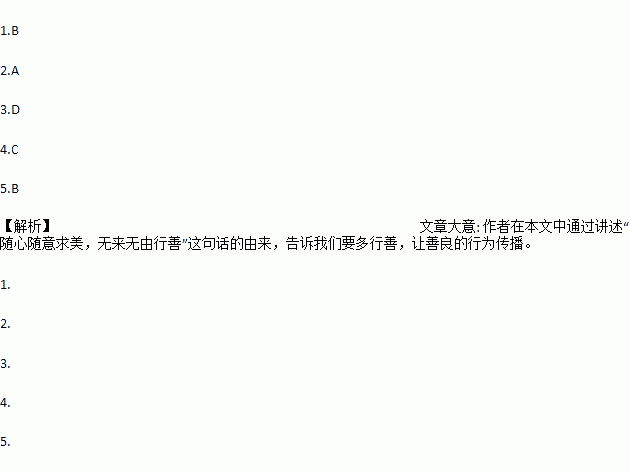题目内容
It was a cold winter day. A woman drove up to the Rainbow Bridge tollbooth(收费站). “I’m paying for myself, and for the six cars behind me,” she said with a smile, handing over seven tickets. One after another, the next six drivers arriving at the tollbooth were informed, “Some lady up ahead already paid your fare.”
It turned out that the woman, Natalie Smith, had read something on a friend’s refrigerator: “Practice random kindness and senseless acts of beauty.” The phrase impressed her so much that she copied it down.
Judy Foreman spotted the same phrase on a warehouse wall far away from home. When it stayed on her mind for days, she gave up and drove all the way back to copy it down. “I thought it was beautiful,” she said, explaining why she’d taken to writing it at the bottom of all her letters, “like a message from above.” Her husband, Frank, liked the phrase so much that he put it up on the classroom wall for his students, one of whom was the daughter of Alice Johnson, a local news reporter. Alice put it in the newspaper, admitting that though she liked it, she didn’t know where it came from or what it really meant.
Two days later, Alice got a call from Anne Herbert, a woman living in Marin. It was in a restaurant that Anne wrote the phrase down on a piece of paper, after turning it around in her mind for days.
“Here’s the idea,” Anne says. “Anything you think there should be more of, do it randomly.” Her fantasies include painting the classrooms of shabby schools, leaving hot meals on kitchen tables in the poor part of town, and giving money secretly to a proud old lady. Anne says, “Kindness can build on itself as much as violence can.”
The acts of random kindness spread. If you were one of those drivers who found your fare paid, who knows what you might have been inspired to do for someone else later. Like all great events, kindness begins slowly, with every single act. Let it be yours!
1.Why did Natalie Smith pay for the six cars behind her?
A. She knew the car drivers well.
B. She wanted to show kindness.
C. She hoped to please others.
D. She had seven tickets.
2.Judy Foreman copied down the phrase because she _________.
A. thought it was beautifully written
B. wanted to know what it really meant
C. decided to write it on a warehouse wall
D. wanted her husband to put it up in the classroom
3.Who came up with the phrase according to the passage?
A. Judy Foreman B. Natalie Smith
C. Alice Johnson D. Anne Herbert
4.Which of the following statements is closest in the meaning to the underlined sentence above?
A. Kindness and violence can change the world.
B. Kindness and violence can affect one’s behavior.
C. Kindness and violence can reproduce themselves.
D. Kindness and violence can shape one’s character.
5.What can we infer from the last paragraph?
A. People should practice random kindness to those in need.
B. People who receive kindness are likely to offer it to others.
C. People should practice random kindness to strangers they meet.
D. People who receive kindness are likely to pay it back to the giver.

